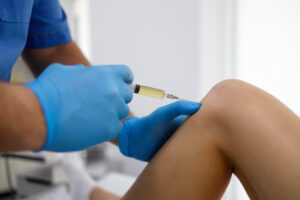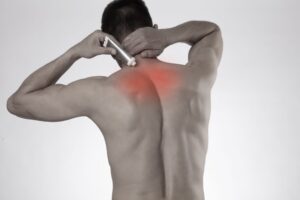PLATELET-RICH PLASMA (PRP)
Platelet-rich plasma (PRP) injections are gaining popularity for a variety of conditions, from sports injuries to hair loss. The treatment uses a patient’s own blood cells to accelerate healing in a specific area.
What is platelet-rich plasma?
Platelet-rich plasma consists of two elements: plasma, or the liquid portion of blood, and platelets, a type of blood cell that plays an important role in healing throughout the body. Platelets are well-known for their clotting abilities, but they also contain growth factors that can trigger cell reproduction and stimulate tissue regeneration or healing in the treated area. Platelet-rich plasma is simply blood that contains more platelets than normal.
To create platelet-rich plasma, clinicians take a blood sample from the patient and place it into a device called a centrifuge that rapidly spins the sample, separating out the other components of the blood from the platelets and concentrating them within the plasma.
What is a PRP injection?
After creating platelet-rich plasma from a patient’s blood sample, that solution is injected into the target area, such as an injured knee or a tendon. In some cases, the clinician may use ultrasound to guide the injection. The idea is to increase the concentration of specific bioproteins or hormones, called growth factors, in a specific area to accelerate the healing process.
The mechanism behind PRP injections is not completely understood. Studies show that the increased concentration of growth factors in platelet-rich plasma may stimulate or speed up the healing process, shortening healing time for injuries, decreasing pain and even encouraging hair growth.
What is PRP treatment used for?
- Hair restoration injections/ hair loss treatment: Hair thinning and loss is frustrating and embarrassing for both men and women. There are many treatment options out there, with varying success rates and costs. Platelet rich plasma injections are an excellent choice for men and women suffering from thin hair and hair loss (alopecia). It is a minimally invasive solution for improving the signs of aging by stimulating hair growth. PRP can also aid in the stimulation of hair growth after hair transplants.
- Skin Rejuvenation: PRP injections are sometimes used as an anti-aging treatment, but there is little evidence to show that PRP reduces wrinkles and other signs of aging.
- Osteoarthritis: Early studies indicate that PRP injections may help treat osteoarthritis pain and stiffness by modulating the joint environment and reducing inflammation, but research is growing.
- Post-surgical Healing: Clinicians first used PRP to accelerate healing after jaw or plastic surgeries. Now, post-surgical PRP injections have expanded to help heal muscles, tendons and ligaments, as procedures on these tissues have notoriously long recovery times.
- Tendon, Ligament, Muscle and Joint Injuries: PRP injections may be able to treat a range of musculoskeletal injuries and conditions.
If you are considering PRP injections, be sure to talk with your health care provider about all the benefits and risks.
Platelet-Rich Fibrin (PRF)
The world of regenerative medicine holds promising solutions for many health and cosmetic concerns, and Platelet-Rich Fibrin (PRF) stands at the forefront. Harnessing the body’s inherent healing prowess, PRF has become a game-changer, transcending fields from dentistry to dermatology.
What is Platelet-Rich Fibrin (PRF)?
Platelet-Rich Fibrin, or PRF, is a second-generation platelet concentrate widely utilized in regenerative medicine for its enhanced healing properties. It’s an autologous product, which means it’s derived from your blood, eliminating the risk of allergic reactions or disease transmission. During preparation, a small amount of blood is drawn and spun in a centrifuge to separate its components. Unlike PRP (Platelet-Rich Plasma), PRF doesn’t involve adding anticoagulants or other chemicals.
It retains a part of the white blood cells. It forms a fibrin clot containing a rich concentration of platelets, growth factors, and cytokines, making it a powerhouse for healing and tissue regeneration. PRF injections treat musculoskeletal conditions, including osteoarthritis, tendinitis, and sports injuries. By enhancing tissue repair and reducing inflammation, PRF can help speed up the recovery of injured muscles, tendons, ligaments, and joints.
For those looking to improve their skin’s health and appearance, PRF treatment can stimulate collagen production, improve skin tone and texture, and reduce the visibility of scars and fine lines. Remember, seeking treatment from experienced professionals who can tailor the procedure to your unique needs is crucial. Whether it’s rejuvenating your skin, accelerating wound healing, or improving surgical outcomes, PRF could be the powerful ally you’re looking for.



